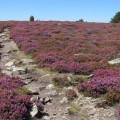Refine your search for walks in Refuge de Font Salesse
Refuge de Font Salesse walks
 Around the Caroux plateau
Around the Caroux plateau

Walk on the Caroux plateau, which offers magnificent views of the Orb valley, the Mediterranean coast and the Pyrenees.
 The Caroux plateau via the Refuge de Font Salesse and the Gorges d'Héric
The Caroux plateau via the Refuge de Font Salesse and the Gorges d'Héric

This 14 km loop takes you past the main points of interest in the area: the Gorges d'Héric, the Refuge de Font Salesse, the Caroux plateau and its orientation table, and the very charming village of Héric.
 Caroux, Espinouse, Heric
Caroux, Espinouse, Heric

Located in the Haut Languedoc Natural Park, the two massifs of Caroux and Espinouse offer a multitude of hikes. I suggest a two-day circuit that allows you to explore a variety of landscapes and admire the abundant wildlife (including mouflons).
The hike starts from the car park below the church in Colombières sur Orb. The bivouac area is located around the summit of Espinouse. The second day is spent returning via the Heric Gorges, with the option of a final detour to the old chestnut groves on the mountainside.
 The Caroux Orientation Table
The Caroux Orientation Table

The Caroux Massif offers a remarkable view of the Hérault plain, the nearby Mediterranean Sea and the Pyrenees in the distance. The orientation table located on a belvedere is the ideal spot to enjoy this panorama.
 Colombières sur Orb - Espinouse
Colombières sur Orb - Espinouse

Day one: Climb up the Colombières Gorges towards the Caroux massif. Cross the Caroux massif towards Douch, then follow the Vialais stream before climbing back up to the Espinouse massif and settling down for the night.
 Le Caroux from the hamlet of Douch
Le Caroux from the hamlet of Douch

This is the third day of the Haut Languedoc journey, which will allow you to discover the Carroux plateau, deliberately abandoned by man. Landscapes as far as the eye can see in characteristic purple heather.
Looking at the route on the map, it is possible to shorten or adjust the hike, but a good sense of direction is essential.
 The Caroux Plateau via the Saut de l'Âne and the Roc de Boutou
The Caroux Plateau via the Saut de l'Âne and the Roc de Boutou

Climb up a little-used path to reach the Caroux plateau. Challenging due to its configuration, the ascent in this part of the massif is wilder than the usual access routes. This hike is for experienced walkers, as the route is not always easy to find and some passages are a little difficult or exposed, but not dangerous.
 Climbing the Roc du Caroux
Climbing the Roc du Caroux

A variation on the classic Caroux plateau hike, allowing you to discover the diversity of the Haut Languedoc's flora and fauna at an altitude of 1,000 metres: deciduous and coniferous forests, streams, peat bogs, and heathland covered in broom and heather. You can also take advantage of an orientation table and sweeping panoramic views of the surrounding mountains and valleys. During the second part of the hike, you will discover the mineral world of the north and west faces of the plateau, which are wilder and less frequented, near Roc Caroux and the mouflon populations.
 The tour of the Caroux plateau
The tour of the Caroux plateau

This iconic hike on the Caroux plateau allows you to discover the diversity of the Haut Languedoc's flora and fauna at an altitude of 1,000 m: deciduous and coniferous forests, streams, peat bogs, orientation table, and heathland covered with broom and heather. You will enjoy sweeping panoramic views of the surrounding mountains and valleys.
